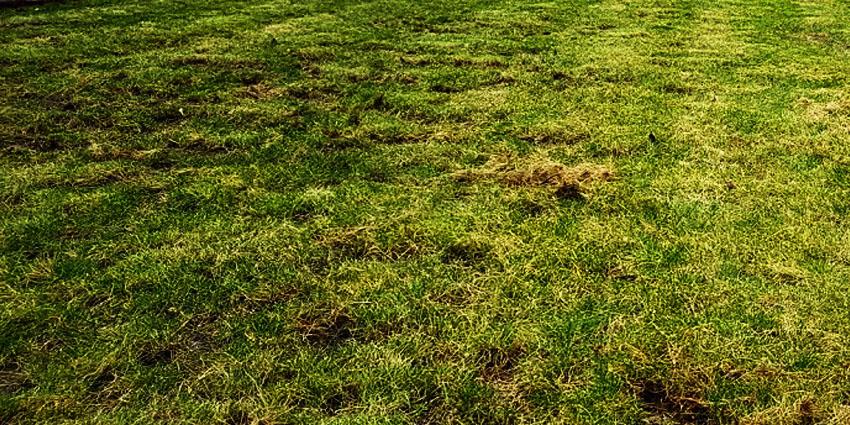
Created By
Matt Adams
Updated On
- July 26, 2024
Get FREE Exclusive Access
Keep your lawn pristine with exclusive tips, offers and insights that I only share with my private subscribers.
Latest Posts
Scarifying: when, why & how to revive a UK lawn afterwards
- By Matt Adams
- July 26, 2024
Jump to
Get FREE Exclusive Access
Keep your lawn pristine with exclusive tips, offers and insights that I only share with my private subscribers.
Scarifying and when to scarify!
It’s a word banded around by the lawn care industry a lot. But why do we put ourselves through all that rake ‘n’ pain- eh?
The truth is, to scarify or to rake a lawn can have massive benefits on it’s growth, look and feel.
In this article I’ll cover the main reasons for scarifying, when and how often you should do it and what to do afterwards to revive the lawn and achieve the best results depending on the different reasons.
We’ll also look at the types of machinery for doing it and which method might be best for you.
If you’re unsure, scarifying is the act of raking over the lawn. So let’s get down to business and start with why? why? why?
Why is Scarifying so important
There are several reasons for scarifying the lawn. The most important thing is what scarifying can achieve; ultimately, It will clear out the old and make way for the new – grass that is
So, here are some of the most popular reasons for giving your lawn a good old going over.
To remove dead moss
Dead moss is super common in the UK. Many people will use either a moss killer or a feed and weed to get rid of it in mid-Spring.
There’s a problem with that though – the moss turns black, then needs to be removed. So, the next thing to do is to get rid of it and scarifying is the number one way to do that. If you have a lawn over 40 square metres, I highly recommend getting an electric one. I think I picked mine up from Aldi for about £40. Not bad eh?
So, save the back and invest in the equipment – it’s defo worth it.
To clear thatch layer
Thatch! You know that light brown stuff under the nice green stuff – that’s known as thatch!. It’s a really common problem with lawns and needs to be got rid of!. You would do this by – yeah, you guessed it – scarifying!
It’s so important to get rid of the thatch, because it stops air getting to the real grass and therefore stops it grow efficiently. It also stops water from draining and it can then cause moss.
So if you have a thatch problem in your lawn, be sure to get your rake out and give it the once over.
To tidy up sideways growing grass blades
Some grass blades grow sideways but don’t actually go brown – they just keep growing and making the lawn look a bit of a mess. A good time to get rid of these is during the Spring, so your lawn can look it’s best when you want to use it in the Summer.
That’s another good reason to rake over the whole area.
To encourage the grass to fill the space
In doing all of the above, the ultimate reason is to give new upcoming shoots a fighting chance against everything – weeds, disease and even the established blades that may take all the nutrients.
So, if you want to do a reseed to tidy up some patches, it’s definitely a great idea to clear out the undergrowth so you can help encourage the newest seed get the best start possible.
Before we move on, here’s a visual summary of the types of tools you could use to get the moss and thatch out. Each tool is explained in more detail below too.
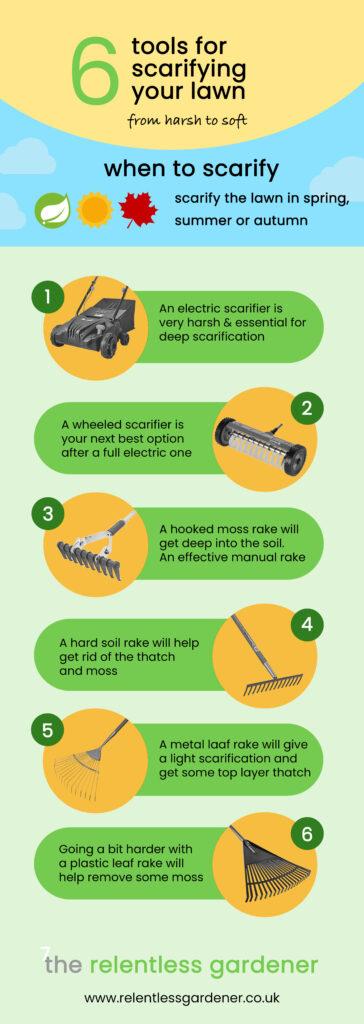
When & how often should you be scarifying your lawn
Scarifying in Spring
If you’re keen to get going on your lawn early in the year – make sure you wait until the grass is growing fully before you do. If you do this job too early in the Spring, you may find weeds come through instead of the grass because the grass won’t be able to recover quickly enough. As it’s not yet started growing.
It’s best to wait until late April. mainly because the grass is in full growth by this time and it’s probably after you’ve done your first mow of the year.
Here’s how my Spring task list looks when caring for the part of our lawn that is under massive trees, in proper shade and prone to moss.
- Sprinkle strong moss killer (ferrous sulphate of iron) in late March or early April.
- Scarify next, but wait until mid-to-late April, when I know the grass is growing strong.
- Apply Signature Spring & Summer Lawn Feed.
- Scarify one more time
- Overseed the bare patches with premium shade grass seed
- Apply a top dressing of either 70/30 or base sand
- Continue with my yearly feed programme
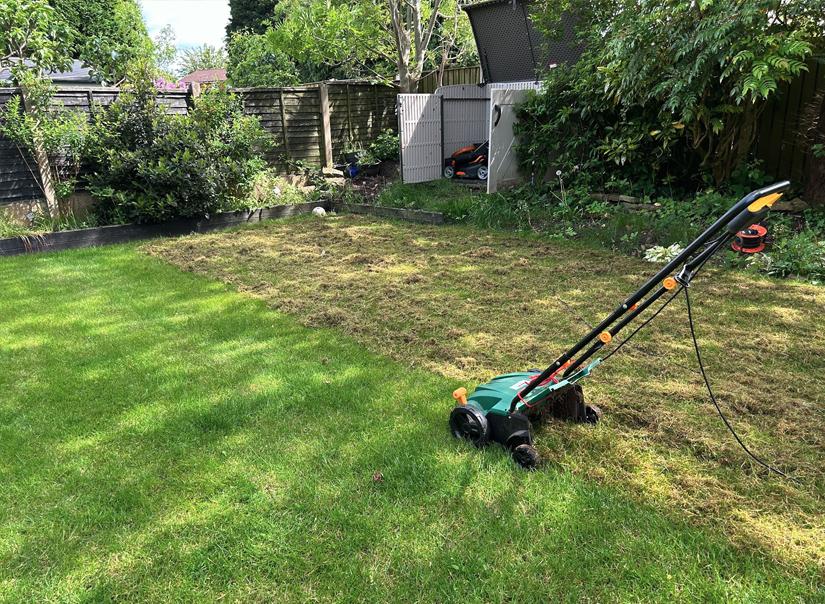
Scarifying in Summer
While Spring is the best time if you want your lawn ready for enjoying during the Summer, the next best time is on a dry day and Summer could therefore the perfect time.
If you’re thinking of doing it in Summer, then try to wait until late Summer. During the Summer, it’s possible the grass will become dormant. Some grass varieties go dormant when the temperature hits over 20 degrees Celsius. If that happens, then the grass is less likely to recover in good time.
So you’re best holding out with the way it looks rather than ruining the lawn in the height of the Summer – probably the time when you want to spend walking on it in bare foot
Scarifying in Autumn
Some websites will tell you that Autumn is by far the best time to scarify because the soil is warm but also moist. Meaning the conditions are perfect.
Doing it in Autumn will definitely help get rid of thatch and your lawn will be highly likely to recover quickly. BY getting rid of the thatch during Autumn you will massively reduce the chances of moss establishing itself during the end of Autumn and Winter.
It’s also true that the grass is still growing in Autumn, which means it’s perfectly fine to go over the lawn with a scarifier.
Can you scarify when its wet?
Scarifying when its wet could give you some difficult repercussions for your lawn. The main problem with wet conditions is that the rake may pull the grass blades out as well as the dead thatch underneath.
If the blades don’t easily avoid the raking, then it’s likely you will pull the roots out when you go over the areas and if the roots come out, you’ll end up with more patches, which will then need overseeding.
So in short, it’s best to find a dry day for scarifying rather than a wet day.
How to revive a lawn after scarifying
Reviving the lawn afterwards is just as important as the job itself. Below are the few steps you can take to reviving your lawn.
Collect the dead grass straight away
If you’re like me and you leave the flap up on the scarifier then you’re going to have a lot of debri on the lawn afterwards.
Be sure to pick it up immediately so it’s not blocking any light.
Personally, I like to use a leaf rake to get as much of it as possible. I also use some leaf collecting hands which help me pick more up to get it in the bin.
Then, I go over it with the mower to collect the last little bits up and trim the good grass one last time.
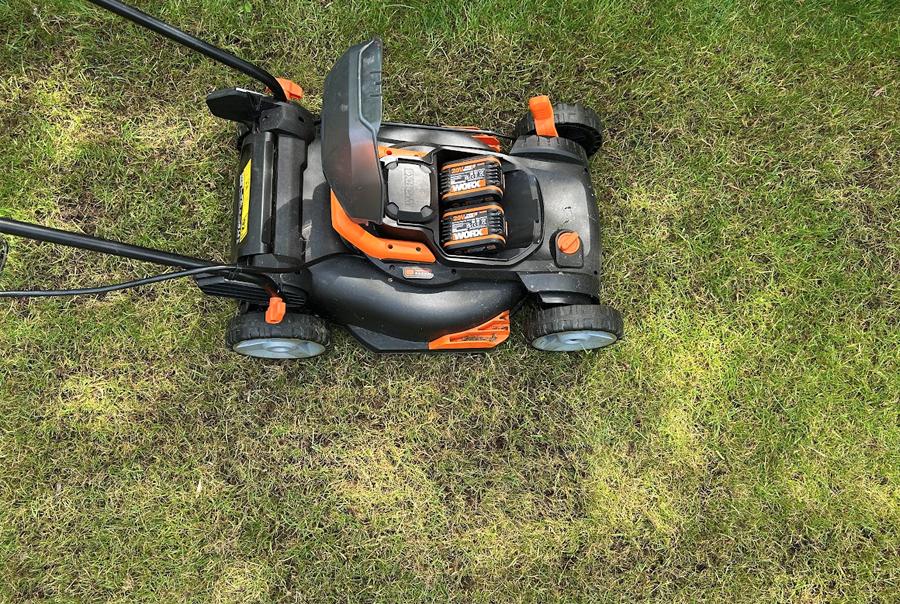
Aerate to let the lawn breathe
Following all this good work, there’s a chance that the soil your lawn is trying to grow in has become even more compact than it was before. So, the best thing you can do afterwards is to go over the whole area with an aerator. That means taking either a garden fork, a tine aerator or a pair of aerating sandals (I know not too fashionable) and running them over the whole area.
Once you’ve decided on your favoured tool, it’s simply a case of piercing holes in the lawn going up and down. It may take a while but it will definitely be worth it.
As another tip – aim to do your aerating when the soil is wet. That way you can get your fork in much easier.
Apply a top dressing (optional)
If you feel your lawn has become uneven after all the work you’ve been doing on it up to this point, then you may want apply a top dressing.
Top dressing comes in a few different forms. There’s 100% top soil or 70/30 soil to sand ratio. There’s even calcified seaweed which is 100% organic and used as a lawn dressing as a great way of conditioning the soil.
If you want to dress your lawn have a read of the benefits of different types before buying a whole load of the stuff. I say that because you need quite a lot per m2 to do a proper job.
Overseed any bare patches
If you’re planning on over seeding, it’s a good idea to lay down pre-seed lawn feed first, By doing so, you will give the new seed the best possible chance of germinating while the established grass uses up some of the nutrients too.
Once done, you can overseed with your chosen grass variety. Usually the rate of overseeding is 35g per m2. However, be sure to check the label on whichever you buy.
Remember you can buy grass seed for different uses. From shady lawns to hard-wearing child friendly varieties, it’s definitely worth a look at what would work best for your garden.
Keep Watered
This is a must after sowing new seed. The soil needs to stay moist but not flooded. So, try to water on a regular basis for a minimum of 2 weeks.
You might be lucky – in Spring there can be showers every day for some periods. So while not the ideal weather for playing on the lawn it’s certainly going to help your new seed germinate.
Types of Scarifier
There are a few types of scarifier you could use and if you’re going to be doing this every year – I highly recommend getting an electric one.
But let’s just take a quick look at your options.
The Simple Rake
Doing your lawn this way will give you some great exercise and if you have a small patch of grass – it’s the perfect option.
I find it best to start in one corner and work my way across the grass to make sure I cover all areas. So don’t worry too much about bringing all the mess with you – you can tidy that up later.
At this point it’s more important that you get the rake tines right under the grass blades so you can pull out as much crap as possible.
If I’m honest, I don’t bother with the rake on my larger patch of grass – I go straight for the electric one, Here’s why.
Using an Electric Scarifier
Don’t go too deep and only do this once!
Oh the dream! – an electric scarifier will pull out so much dead stuff from the lawn that you won’t know what to do with it – of course you can stick it on the compost heap – if you haven’t applied any weed killer recently.
In terms of pricing, you should be able to pick one up for as little as £60 and they will range upward from there. I’ve seen some on the market for £200
Anyway – the first time you do the lawn with an electric scarifier you’ll be shocked as to how much stuff could possibly be in the grass. You’ll probably want to show your partner too – just for laughs.
The electric ones usually have 2 blades – one for raking and one for doing a deep scarification too. They both do a great job but the aerating blade will mess up your lawn more so it may take a bit longer to revive it afterwards.
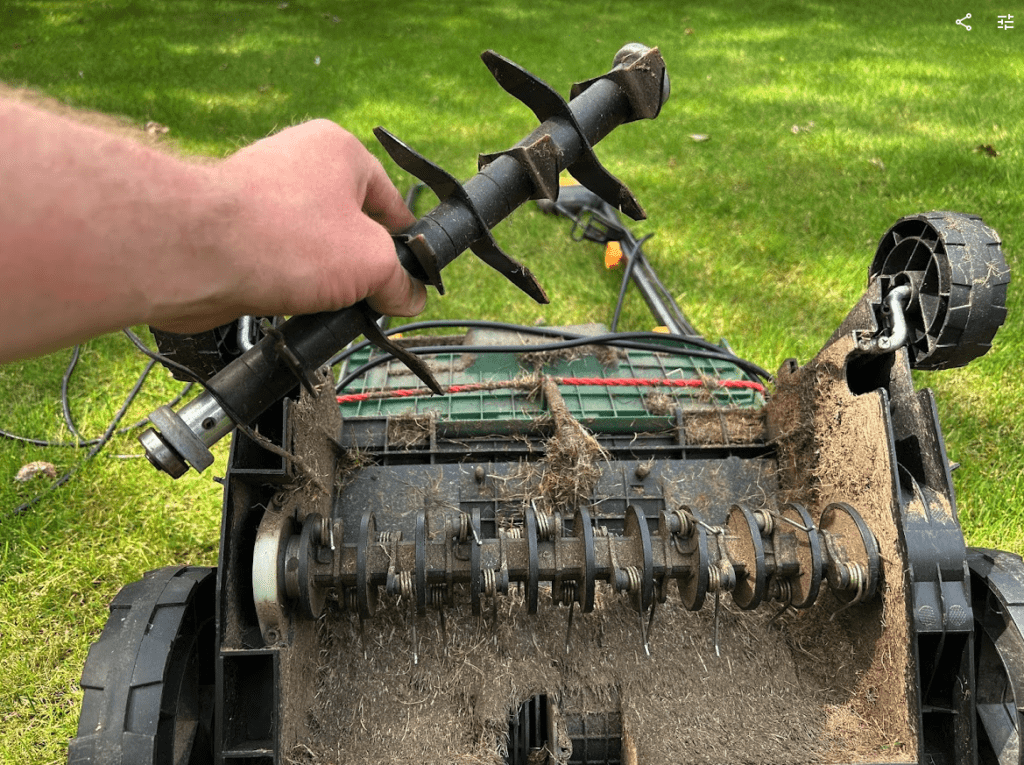
Oh and one more tip – many of the electric scarifiers come with a back box. But they fill up sooo quickly. So I prefer to take the back box off and tie the flap to the bars with a bit of string so that everything just gets spat out of the back,. Make sure you wear trousers though as you don’t want stones hitting you in the shins – oofff!
Then I just rake it up and go over with the lawn mower (on a higher setting) to get the rest – it has a much bigger and better back box so work a treat.

This Post Has 21 Comments
Hi Roy,
Can I please ask, which blade in your picture of a scarifier is the aereating one and the scarifying one? Thank you!
I have wet lawn on clay soil with moss and weeds. Should I use weed and feed to kill the moss. Then scarify to remove dead moss etc. Then aerate and re seed ?
Hi Matt,
Can you tell me , if l have this in the correct order.
– pre- seeding fertiliser
-scarify
-seeding
-compost
-wetting agent
-water
Thank you.
Hi Roy,
That looks good to me. However I would apply the feed after scarifying to make sure it gets into the soil quicker. Hope that helps. Matt
5 September 2024 Hello Matt. I am about to use an electric scarifier on my lawn which has deep, deep thatch. How does the machine manage to rake out the thatch only, without pulling up the grass above? Thanks in advance for your response. Sue
You may well pull up grass but some will definitely remain and recover itself. The lower you go with the scarifier, the more likely you are to need an overseed afterwards. Hope that helps.
Hi Matt, lawn full of weeds, should I kill weeds and moss first, then start the scarify, seed and topsoil process? Have seen conflicting advice on whether to kill weeds before or after scarification.
I’d personally get rid of as many as possible first but remember if you use a herbicide, you’ll need to wait 6-8 weeks before overseeding. Hope that helps
Hi, looking to overseed a lawn full of weeds and moss as well as partly shade and clay soil. I have put a strong weed killer and have seen I need to wait around 6 weeks for overseeding.
I have understood from reading the website that these would be the best steps. Am I correct?
– Scarify
– pre-seeding fertiliser
– seeding
– top soil 30/70 mix
The seeding is before the top soil. Correct?
Thank you
I usually add top soil after seeding because it helps with seed-soil contact and has the added bonus of hiding it from the birds.
Will the spring attachment on a standard type blade work? I think it’s called a thatcher blade.
Yeah for sure.
Hi! How soon after scarification can one walk on and use the lawn for leisure please? Thanks for your advice.
You can walk on it straight away but you might be walking on soil rather than grass. Depends how hard you scarify
I’ve not cut lawn this year yet but is full of creeping buttercups (we live rurally so always a pain!). Have recently gone over lawns with lawn Weedol to try and zap them, but would you recommend to mow, then iron sulphate, then scarify in April, followed by seeding the bare bits (there will be loads)…or something different? Heavy, boggy soil but this year am determined to wage war on the lawns!! Want to make sure we do things in the right order…!
Hi there
My new robotic lawnmower has thin spikey wheels with four wheel drive (Ambrogio L60 Elite S+) But the wheels keep digging into the grass / ground and stalling. I have a lot of thatch and moss . The other day I managed to scarify a part of the garden but then the rain came on. Yesterday I managed to cut the grass again but the thatch is like a spongy carpet and my robot lawnmower is just getting stuck in it at the highest cutting setting. I am sort of at a loss as what to do. The robot was £1200.00 and probably not a good investment for me. I feel these wheels work great in places like Australia where they give this robot fantastic reviews but the ground over there is dry and solid where as here in the UK it is soft most of the time. Do you have any tips for me to solve this?
If you ant to rectify this problem it would be best to apply sand or 70/30 sand/soil mix. That will help to level out the area. Here’s my blog on that How to level a bumpy lawn using a compost, topsoil or sand mix
Hi, should i use the aerating blade first and then go over with the tine blade, im a very novice gardener but want my grass to look the bees knees, bit of a turf war on our cul de sac lol
Hi Anne,
yeah that would work – or just do the aerating blade as that acts as a rake too.
Cheers,
Matt
Hi Matt,
How long should you leave it between scarifying and Aerating?
Then how long after Aerating would you leave it before you put the pre seed down?
You can do these tasks simultaneously. Meaning you don’t need to wait and could do them all on the same day if time allows.